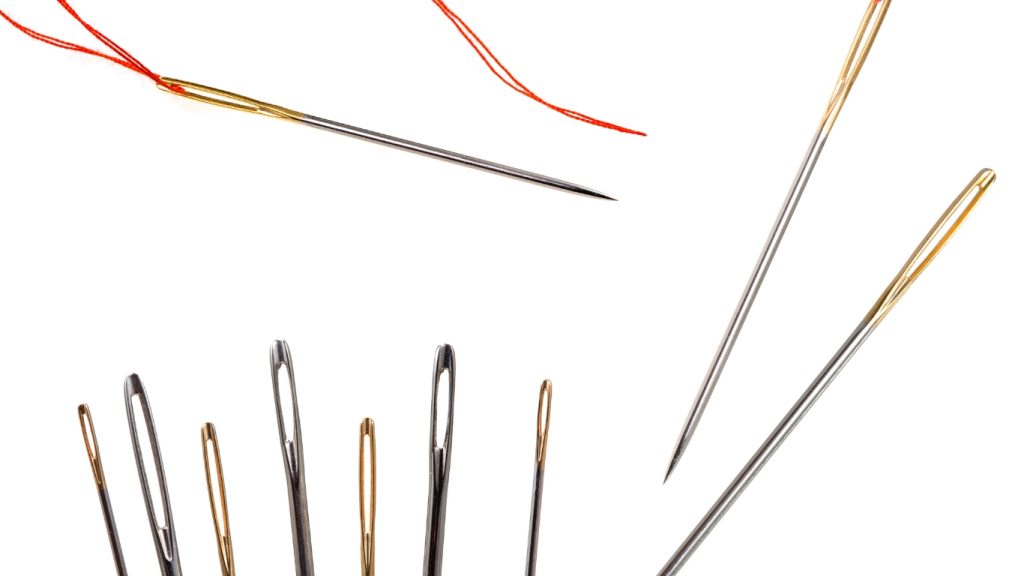
I recently bought some tiny beads to add a bit of sparkle to my hand sewn designs — but when I went to stitch them in, I quickly realised the needles I had were far too big. That small frustration led me down a rabbit hole of research into which needles work best for different hand sewing techniques and materials. So, to save you the same hassle, I’m sharing what I found in this complete guide to embroidery needles and when to use each one.
Whether you’re hand-stitching a delicate floral pattern or crafting bold, modern embroidery art, this guide will help you choose the best embroidery needle for the job.
Why the Right Hand Sewing Needle Matters
Before diving into the different types, it’s important to understand why needle choice matters. The type of needle you use affects:
- Thread movement through the fabric
- Ease of stitching
- Fabric integrity (avoiding puckering or holes)
- Overall embroidery finish
With so many embroidery techniques and fabrics available, choosing the right needle is key for a smooth, professional result.

1. Crewel Needles (Also Known as Embroidery Needles)
Best for: General hand, surface & outline stitch embroidery
Crewel needles are the most common hand embroidery needles. They have a medium-length shaft, a sharp point, and a slightly longer eye than regular sewing needles — ideal for threading multiple strands of embroidery floss.
When to use: Perfect for stitches like backstitch, satin stitch, and French knots on medium-weight fabrics.
2. Tapestry Needles
Best for: Cross-stitch, counted-thread embroidery, needlepoint
Tapestry needles have a blunt tip and a large eye. The blunt end helps guide the needle through the holes in evenweave fabrics without splitting the threads.
When to use: Ideal for counted embroidery on Aida, linen or evenweave fabrics. Use a size that suits your fabric count — the higher the count, the smaller the needle.
3. Chenille Needles
Best for: Ribbon embroidery, crewelwork, heavy threads
Chenille needles are similar to tapestry needles but have a sharp point and an extra-large eye. They’re excellent for thicker threads, yarns or embroidery ribbons.
When to use: Great for textured embroidery or when working with thicker fabrics and decorative threads like wool or silk ribbon.
4. Milliners Needles (Straw Needles)
Best for: Bullion knots, French knots, decorative wrapped stitches
Milliners needles are long, thin, and have a small eye and sharp point. Unlike most needles, the shaft and eye are the same width, which makes them perfect for wrapping stitches.
When to use: Ideal for decorative stitches that involve wrapping the thread around the needle multiple times, such as bullion knots and cast-on stitches.
5. Beading Needles
Best for: Embellishing embroidery with beads or sequins
Beading needles are ultra-fine with a narrow eye, allowing them to pass easily through tiny bead holes.
When to use: Use beading needles when adding seed beads or sequins to your embroidery. They’re essential for intricate, embellished designs.
Choosing the Right Size Needle
Needles come in various sizes — the higher the number, the finer the needle. Your needle should suit both your thread and fabric:
- Thicker threads = lower number (larger needle)
- Finer threads or fabrics = higher number (smaller needle)
A good rule of thumb: the needle should create a hole just large enough for the thread to pass through without resistance.
Quick Embroidery Needle Reference Table
| Needle Type | Best For | Point | Eye Size |
|---|---|---|---|
| Crewel | General embroidery | Sharp | Medium |
| Tapestry | Cross-stitch | Blunt | Large |
| Chenille | Ribbon embroidery | Sharp | Extra-large |
| Milliners | Bullion knots | Sharp | Small |
| Beading | Embellishments | Sharp | Very small |
Final Thoughts
Having the right needle can take your stitching from frustrating to flawless. From delicate threadwork to bold embellishments, each type of needle serves a purpose. Whether you’re just starting out in hand sewing or looking to level up your technique, investing in a variety of needles will give your designs a more professional finish.
For more tips and tutorials on embroidery tools, threads and techniques, browse our latest articles and check out the latest patterns on our etsy store.